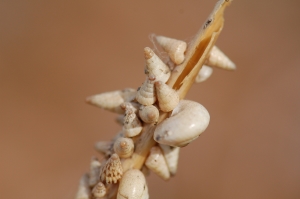
Key Points
- Autumn is most effective time of year to bait snails.
- Timing bait application when snails become active in early autumn but before they begin egg laying is essential.
- Baits will be less effective if exposed to significant heat or high rainfall.
Introduced round and conical snails cause significant economic losses to Australian growers and require an effective management response, which includes baiting.
The latest research reinforces the message that the optimal time to target snails with bait is in autumn before reproduction, according to South Australian Research and Development Institute (SARDI*) entomologist Helen Brodie, who has been studying effective methods of snail control.
"The aim of baiting is to control snail populations by knocking out mature snails before significant reproduction has occurred," she says.
"Snails are most efficiently killed by baiting in autumn."
Since 2017, a GRDC investment led by SARDI has investigated the seasonal activity patterns of snails in different conditions across eight sites in South Australia and Western Australia to gather information on the optimal time to bait for snails.
This research found that:
- For common white snails in SA and WA, reproduction generally occurred from April to mid-spring.
- The onset of reproduction can vary greatly from year to year and is largely dependent on rainfall. A wet start can lead to earlier snail reproduction (Figure 1).
- Increasing proportions of snails 'shut down' their breeding activities between August to October depending on the finish to the season.
- Interestingly, snail baits appear to kill snails more efficiently during times of the year coinciding with snail reproduction, as shown by time series studies.
"These results reinforce the need for growers to concentrate baiting efforts in autumn, which is prior to reproduction and also the time when baits kill snails most efficiently," Ms Brodie says.
Figure 1: Albumen (reproductive) gland measurements over time of common white snails at Gairdner, WA, together with total monthly rainfall (blue shading). Black dots each represent a single snail. Enlarged glands (above the dotted black line) indicate that snails are reproductively active. Note: gland enlargement commenced in February of 2017 coinciding with high summer rainfall, but later (May) in 2018 coinciding with a dry start.

Source: Brodie et al. 2020, GRDC Update Paper – Snail management – learnings from recent studies, February 2020
Effective baiting
Ms Brodie says of the few molluscicide active ingredients available, metaldehyde is the most commonly used.
"Unfortunately, snail baits in general are not attractive to snails over distance," Ms Brodie says.
"They will not seek the baits out, so the baits need to be placed at a time and sufficient density to ensure snails encounter them before the baits degrade and become less effective.
"Baits must be applied just before prolonged periods of snail activity to ensure pellet encounter. If growers are unsure whether snails are active then it is best to bait a small area and check for dead snails after a few days."
It is important to gain an even spread of snail bait by calibrating spreaders for the selected bait product, and monitoring outputs.
Optimal baiting efficacy requires at least 30 pellets per square metre (table 1). In areas of higher snail densities, up to 60 pellets/m2 may be required to avoid complete consumption of pellets and to ensure adequate rates of encounter. If this is above the registered rate of the product, repeat applications may be necessary, ensuring label directions are followed.
Table 1: Pellet densities for registered rates of some different bait products in Australian broad-acre grain production.
| Product | Registered rate (kg/ha) | Pellets per m² |
|---|---|---|
| Meta (15g/kg metaldehyde) | 5-7.5 | 25 |
| Metarex (50g/kg metaldehyde) | 5-8 | 35 |
| Eradicate Snail and Slug Killer (60g/kg Iron EDTA complex) | 5-16 | 25 |
Source: GRDC Update Paper – Snail management – learnings from recent studies, February 2020
Will bait degrade?
Ms Brodie says it is important for baits to be stored correctly and to be deployed at the right time to ensure maximum effectiveness.
"Environmental conditions will affect bait efficiency. We found that exposure of baits to high temperatures did reduce the active ingredient concentration over time, but UV exposure had no effect," she says.
"Iron chelate products are less effective if exposed to rainfall above 35 millimetres, however, extended high rainfall will break down most bran-based pellets regardless of active ingredient.
"It is important to be aware of the temperature and rainfall forecast before spreading baits, and to store snail pellets in cool and dry conditions.
"Storing baits in a shed where the temperature regularly exceeds 40 degrees Celsius (°C) can cause bait degradation."
Tests of bait efficiency after storage in different environments were conducted on white Italian snails and found:
- Baits stored at high temperatures for seven days before being used were less effective on snail numbers.
- When storing baits before use, the concentration of metaldehyde, the active ingredient, decreased when stored above 20°C. It reduced approximately one gram per kilogram for every 10 degrees above 20°C for Meta baits and 4g/kg for Metarex baits.
More Information
Helen Brodie
08 8429 0557






